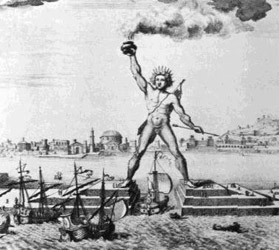
Max Cavitch, one of the best readers of Lazarus’s poem, reminds us that when the Statue was dedicated in 1886, “the voice of liberty was, in
many respects, the voice of anarchy.” With the Haymarket Riots of the previous May clearly in mind, the organizers of the dedication ceremony shipped in a huge police presence: As the New York Times reported, “A battery of regulars was stationed near the water’s edge, and a detachment of infantry did guard duty on various parts of the island. Sentinels paced up and down the stand in front of the speakers’ platform,” on which President Cleveland, “his face wreathed with smiles,” was seated.

 Like Abraham of Ur, Emma Lazarus was a smasher of idols. Here she blasts the ancient Colossus of Rhodes, an image of the Titan
Like Abraham of Ur, Emma Lazarus was a smasher of idols. Here she blasts the ancient Colossus of Rhodes, an image of the Titan
 During his twenties, my gynecologist was a National Park Service ranger at the Statue of Liberty. He picked an odd moment to let me know he had gone “all the way up to the torch.” That’s no longer possible, at least not for the public.
During his twenties, my gynecologist was a National Park Service ranger at the Statue of Liberty. He picked an odd moment to let me know he had gone “all the way up to the torch.” That’s no longer possible, at least not for the public.
 Max Cavitch, one of the best readers of Lazarus’s poem, reminds us that when the Statue was dedicated in 1886, “the voice of liberty was, in
Max Cavitch, one of the best readers of Lazarus’s poem, reminds us that when the Statue was dedicated in 1886, “the voice of liberty was, in
 She saw the “huddled masses” at closer range than the Statue of Liberty ever did. After “plunging...recklessly and impulsively” into a defense of the Russian Jewish immigrants in the Century Magazine, Lazarus threw herself into
She saw the “huddled masses” at closer range than the Statue of Liberty ever did. After “plunging...recklessly and impulsively” into a defense of the Russian Jewish immigrants in the Century Magazine, Lazarus threw herself into
 Esther Schor — a poet and professor of English at Princeton University — is the author of Emma Lazarus, a biography published by Nextbook Press and Schocken Books as part of the Jewish Encounters book series. To learn more, and to buy the book, visit www.nextbookpress.com.
Esther Schor — a poet and professor of English at Princeton University — is the author of Emma Lazarus, a biography published by Nextbook Press and Schocken Books as part of the Jewish Encounters book series. To learn more, and to buy the book, visit www.nextbookpress.com.